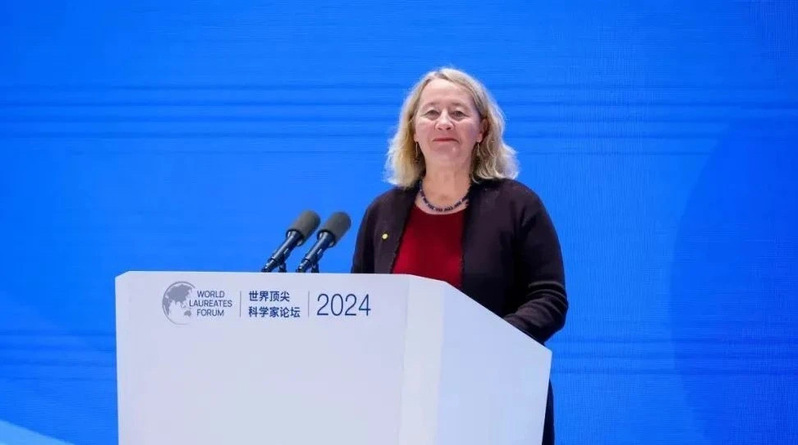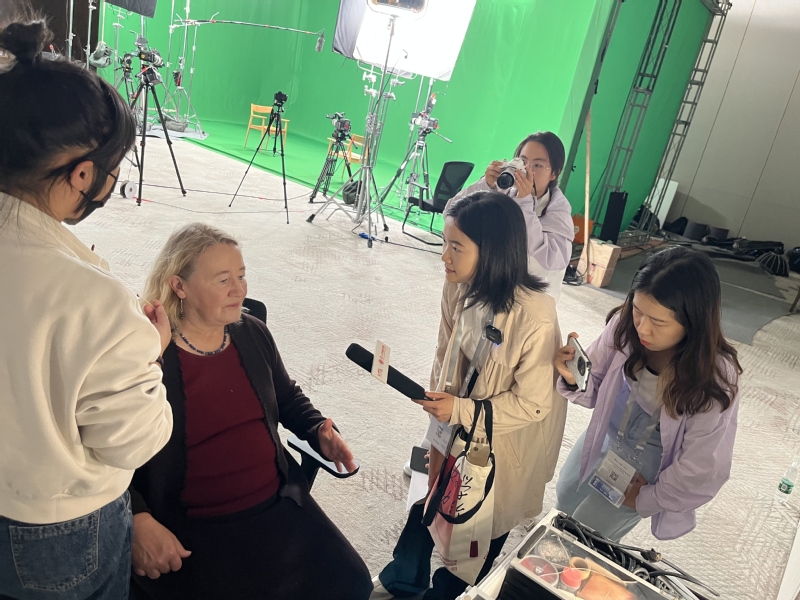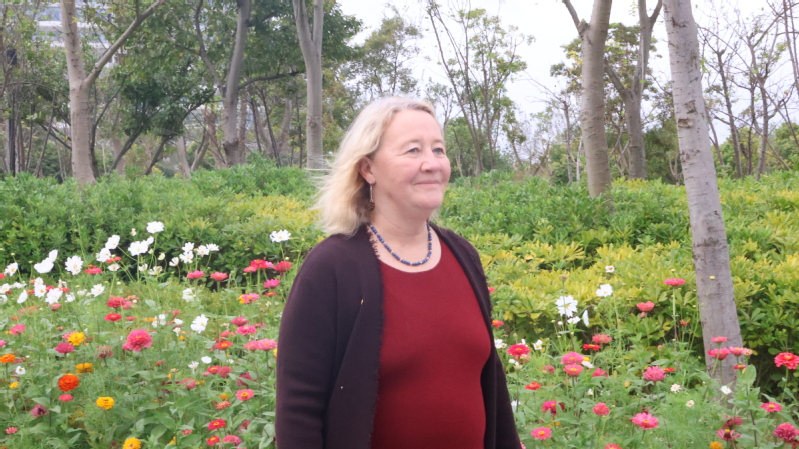By Sun Suying, Zhang Siyuan, Jiang Ziyi and Dou Fengchang
Basic research reveals the fundamentals of how things can work, while translational research then takes those and help them affect human health. Both are indispensable, said Carol Greider, the Nobel Prize recipient in physiology or medicine in 2009, at the 2024 WLA Forum in Shanghai on October 25.
Greider was paying a fleeting visit to Shanghai so we could only speak with her in a makeup room before another arranged interview or on the way to the next event. Friendly and approachable, she answered questions with a calm, gentle demeanor. Yet, when the topic turned to science, her face lit up with enthusiasm. “Scientific research is always a surprise. It’s like doing a puzzle and finding something out,” said Greider.

Greider delivers a keynote speech at the WLA Forum. (Photo: WLA)
AI Will Lead to More Revolutionary Discoveries
The aging of organisms can be traced to the microscopic level of molecular biology, where telomeres are critical for the health and survival of all living cells.
Telomeres, DNA sequences located at the ends of chromosomes, are essential for maintaining the length and integrity of chromosome ends. In 1984, Greider discovered an enzyme called telomerase, which adds sequences back onto the chromosome. Greider was acknowledged with the 2009 Nobel Prize in physiology or medicine, along with her mentor Elizabeth Blackburn of UCSF and Jack Szostak of Harvard Medical School, for their discovery of molecular nature of telomeres.
Greider has been doing research in understanding how telomeres maintain chromosome ends and regulate cellular aging for over 40 years.
“Today, I’m going to tell you a story, and this is a story about curiosity-driven research. And the focus of the talk is on telomeres and how new technology allows new approaches to disease,” said Greider in the keynote opening speech at the 2024 WLA Forum.
Using nanopore sequencing technology, Greider and her team have mapped telomere lengths across different chromosome ends, challenging existing scientific assumptions. Their findings reveal a unique distribution pattern, which could provide insights into treatments for cancer and degenerative diseases.
Greider once mentioned in an article published this year that this discovery suggests humans have yet to fully grasp how telomere length is regulated — a crucial factor affecting human health. Short telomeres can lead to age-related degenerative diseases, while overly long telomeres may increase cancer risk.
“We want to understand why telomere lengths vary at different chromosome ends. By understanding this, we might be able to change telomere lengths to treat disease,” explained Greider.
Greider believes that artificial intelligence is revolutionizing molecular biology, particularly in fields like protein structure prediction, where traditional sequencing methods fall short.
“This is a biological revolution,” she said. I anticipate that there's going to be more revolutionary discoveries using AI, and I'm hoping to collaborate with people to see how that might affect our telomere length studies.

Greider is interviewed by People’s Daily in a make-up room.(Photo prided to People’s Daily)
Best Christmas Gift — Discovering Telomerase
In December 1984, as a 23-year-old doctoral student in molecular biology, Greider entered her lab at UC Berkeley, eager to see if her experiment set a week ago had yielded results. She was on a quest to find biochemical evidence for telomere elongation — a quest that had already lasted for several years.
Her discovery that day would ultimately bring her a Nobel Prize.
In the early 1970s, biologists Alexey Olovnikov and James Watson pointed out a “end replication problem” in chromosomes: lacking a means to replicate chromosomes ends, chromosomes would shorten with each cell division, eventually result in cell aging or death.
Greider’s mentor Blackburn, and Blackburn’s mentor, Joseph Gall, discovered that the ends of chromosomes in Tetrahymena thermophila contain simple, repeated DNA sequences. This discovery served as a key to understand end-replication problem. Blackburn and Szostak later showed that these repeated sequences help maintain the stability of chromosomes and protect them from damage. They posited that there might be a new enzyme to add these sequences to chromosome ends, and Greider’s task was to find biochemical evidence for such an enzyme.
On Christmas Day in 1984, Greider found the evidence she’d been looking for on an experimental gel: the pattern that would be expected from an enzyme that could add specific DNA sequences to chromosome ends. But rather than celebrating immediately, she and Blackburn held back to validate whether this was truly evidence of a new enzyme.
After nine months of experimental validation, Greider and Blackburn confirmed the discovery was indeed a new enzyme and not an existing polymerase. They named it “telomere terminal transferase” and later shortened it to “telomerase.”Reflecting on the day that made a breakthrough discovery, Greider recalled, “I went home, turned on some music, and danced.”

Greider is in the lab.( Photo: Nobel Prize website)
“A Diverse Team Leads to Better Decision-Making”
After finishing an interview with a media outlet, Greider set off to her next event, conversing with us on the way. When asked about gender equality in science, she paused thoughtfully and said, “It's getting better, but too slowly.”
As an early advocate for gender diversity in science, Greider has long been concerned about the underrepresentation of women and has worked to increase visibility for female scientists. She has been involved in initiatives aimed at preventing and addressing harassment in biomedical fields, and she was the lead author of a 2019 policy paper in Science calling for structural changes to promote gender diversity in STEM.
Telomere research, which Greider helped trailblaze, has attracted many female scientists—a phenomenon she attributed to a founder effect. Early support from cell biologist Joseph Gall, who was supportive of women in science, paved the way for Blackburn, who joined Gall’s lab and later became Greider’s mentor. This created a positive cycle that welcomed and supported more women to join the field.
In 2009, at a press conference at Johns Hopkins University celebrating her Nobel Prize, Greider appeared with her children, then 13-year-old Charles and 9-year-old Gwendolyn. “How many men have won the Nobel in the last few years, and they have kids the same age as mine, and their kids aren't in the picture?” she pointed out. “That makes a statement.”
Greider believed that diverse research teams led to better decisions. “The more diverse a group you have, the better decision-making is. With people bringing in different perspectives, you’re more likely to get to the right answer sooner.”

Greider is at Dishui Lake, Shanghai.( Photo provided to People’s Daily.)
“Don’t Be Afraid to Challenge What’s Established”
When asked what drove her to remain so committed to telomere and telomerase research after all these years, a warm smile spread across her face. “There’s always something new,” she replied, emphasizing the word “new.”
For Greider, curiosity has been her North Star, guiding her to pursue fascinating questions she found and explore each new question with unwavering devotion. “Each time we do a series of experiments, there are going to be three or four new questions that come up when you think you’ve answered one,” she added.
On various occasions, Greider has consistently emphasized the importance of “curiosity-driven science.” She paid tribute to curiosity-driven science on the day she won the Nobel Prize:We didn't know at the time that there were any particular disease implications. We were just interested in the fundamental questions of cell biology.
Why is curiosity so crucial? “Because that's how we find out something new,” Greider explained. “If you're not following your curiosity, you'll only find what we already know. But if you're just curious and you let your mind go to different places, then that's how we get to new places.”
When asked about suggestions for young people beginning their careers in science, Greider highlighted perseverance as the most important keyword. She stressed, “In science, most experiments don't work, and just going forward and doing the next experiment and not worrying that it didn't work.” She also emphasized the importance of engaging with others and cautioned, “You can’t know everything by yourself. Talking with others gives you a sense of whether you're on right track or not.”
As we walked through the forum venue, Greider shared her hopes for the next generation. “Be skeptical and excited about the new things being learned. Don't be afraid of going against what is already established. That is the key to doing something new,” she said.

